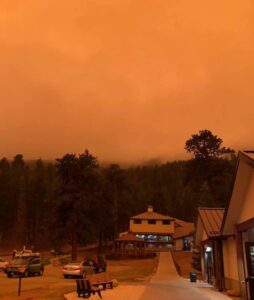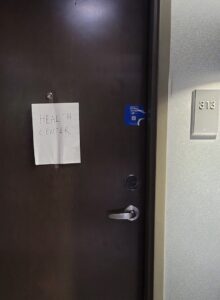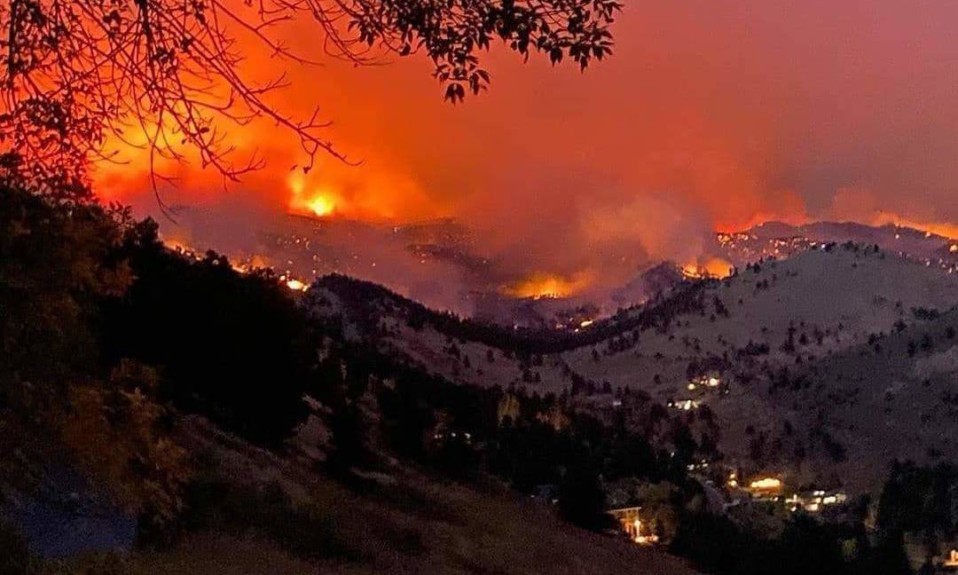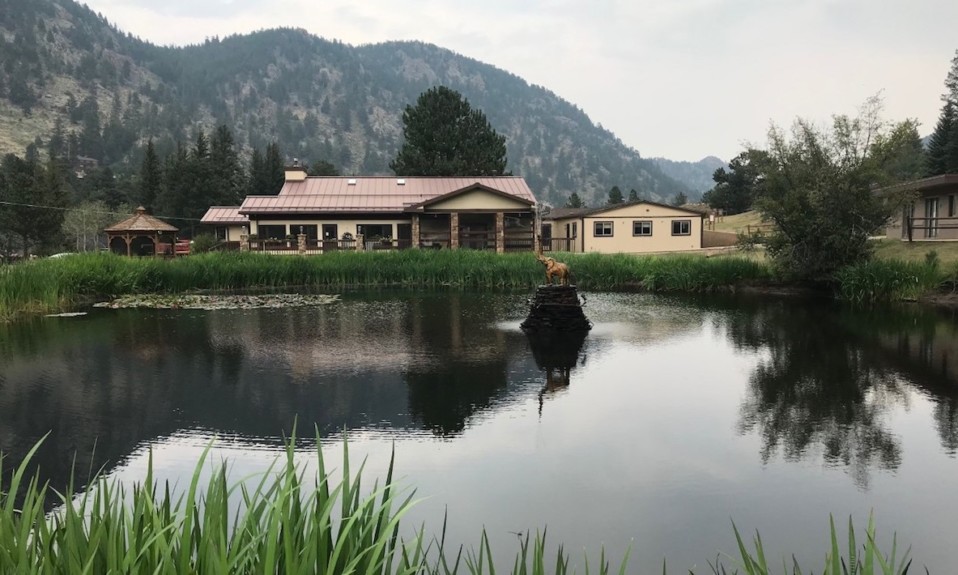Staff members and clients recount the harrowing East Troublesome blaze that displaced them from their Colorado treatment center last October
By Jennifer Taylor
On the morning of Oct. 22, 2020, Jim Geckler sped off in his car to work and braced for the worst. He remembers looking up at the mountain peaks in the distance. “I could see the ring of fire,” he says. “To see actual flames is very, very scary.”
There wouldn’t be much time. The CEO of Harmony Foundation, an addiction treatment center located on the eastern border of Rocky Mountain National Park in Estes Park, Colo., and his staff had a plan in place. They just never expected they’d have to execute it.
At 9 a.m., Geckler held a leadership meeting to go over the steps. Not long after, the center’s staff met with its residential clients, assuring them they were ready to act if necessary. Two and a half hours later, the call came: Local officials announced a voluntary evacuation of Estes Park. It was time.
There’s not a whole lot you can do about this. You can shout at the heavens all you want, but it’s not going to change the situation.”—Matt Martin, Harmony Foundation alumnus
By 12:30 p.m., the entire campus—clients, staff, medical records, medications and limited belongings—had been packed into a 25-vehicle caravan, headed for safer ground. There was no panic, but as Geckler slid behind the wheel of his car, he thought this might be his last sight of the buildings that make up Harmony Foundation. Then he shifted his gaze to the darkening midday sky. It was a swirl of orange, yellow and brown.
The Harmony Foundation Evacuation Plan
The plans had started coming together days earlier. The weekend before, the East Troublesome forest fire—the second-largest in Colorado history, engulfing more than 193,000 acres—had begun approaching Estes Park at a steady clip. Yet Geckler recalls an initial false sense of security. To reach Harmony, the flames would have to jump the Continental Divide—an area in Rocky Mountain National Park above the tree line, meaning there was very little plant life to fuel the blaze.
“When it did jump [the Continental Divide], that’s really when it became urgent we put a plan in place,” Geckler says.

For the previous several years, Harmony Foundation had focused on emergency training and preparation work, according to Ross Bisson, who serves a dual role at the treatment center as director of facilities and safety. In the past, they had experienced floods and regular power outages. But this was the first time in the center’s 52-year history that evacuation from its 42-acre mountain setting was imminent. The preparations, Bisson recalls, paid off.
Plumes of smoke closed in; the air was thick. Choking from the fumes, Bisson tended to the evacuation and equipped leaders with copies of the plan. “Everyone knew their roles,” he says. “That was one of the best things we did because it was fresh in their minds.”
The leadership team was ready for the worst of outcomes. It had developed contingency plans to place clients at a nearby treatment facility in case Harmony Foundation was destroyed. Years earlier, Harmony had switched its electronic records to a cloud-based system. Incoming calls were shifted to Harmony’s Fort Collins, Colo., facility in anticipation of worried family members reaching out. Says Geckler of those two moves, “That saved us.”
Days earlier, Denver resident Veronica Holyfield had checked herself into Harmony. She and the other clients were kept apprised of the fires, yet they continued with their daily schedule. It wasn’t until they returned from a rock-climbing outing on the fateful morning that plans changed—immediately. They began evacuating. Holyfield looked up at the sky, and it was unlike anything she’d ever seen.
“The sky was this royal purple,” she remembers. “It felt like the apocalypse coming to life.”
One Road Out for the Harmony Foundation
From the road—the only one still open—they could see billowing clouds of smoke clinging to the mountaintops. Ash fell from the air like rain. A staff member piloted the first car in the caravan, and Geckler brought up the rear. Together they navigated 60 clients and 50 staffers out of Estes Park, even after cellphone service cut out and they were unable to communicate with each other.
By dawn that day, the Troublesome fire already had burned hundreds of structures in its path and killed a local couple who, according to news reports, had refused to evacuate. For local fire officials, the most astonishing aspect of the blaze was how quickly it grew. In less than a day, it engulfed more than 120,000 acres, making it the most rapidly expanding fire in state history. That speed made it difficult for firefighters to react, as did the unpredictable path of the flames.

Complicating matters on the road were tourists, many of whom had ventured to Estes Park for a reprieve from the COVID-19 pandemic, says Geckler. It was something they hadn’t planned for—they were not the only people evacuating. Despite being split up by cars merging onto U.S. Route 34, the caravan snaked down out of the mountains and headed to Greeley, Colo., 50 miles east. There, a DoubleTree hotel, mostly vacant due to the pandemic, was ready to receive Harmony Foundation as well as other evacuees.
By four o’clock, we were back in groups. We didn’t miss a beat.”—Harmony CEO Jim Geckler
Meanwhile, Bisson hung back on the Harmony campus to conduct final checks of all the buildings. Facility vehicles were moved to the safest place—the middle of the parking lot—and backup generators were put in place. Then Bisson and a fellow staffer glanced at each other and the grounds. “Take a last look at this,” Bisson said. “It may not be here anymore.”
A Makeshift Treatment Center
Inside the DoubleTree, the center’s staff was organizing how to serve clients dinner. A makeshift health center for “detox” and spaces for various community and therapeutic groups were established in conference rooms that had been set aside by the hotel. The objective, according to Harmony Foundation counseling manager Joseph Snoha, was to stick to the schedule. Clients were assigned two to a room and came and went between the conference spaces.
“By four o’clock, we were back in groups,” Geckler says. “We didn’t miss a beat.”
Holyfield and her fellow clients remained sharply focused on their recovery mission, despite being thrust into a real-life setting and all the temptations that came with it, including a full-service bar on the first floor and alcohol for sale in the hotel shop. “The trauma-bonding adventure helped us want to continue treatment in the hotel,” she says. “We just overcame this crazy thing. No way are we leaving.”

Frasier, Colo., resident Matt Martin had two years of sobriety under his belt before checking in at Harmony a week before the evacuation. He was there for a 12-day recommitment program and marveled at the hotel setup and the Harmony staff’s can-do spirit.
“There’s not a whole lot you can do about this,” he says. “You can shout at the heavens all you want, but it’s not going to change the situation.”
What was initially expected to be a one-night stay stretched into a week.
“It began to be more stressful for the clients as time went on,” Snoha says. Some of the clients had dietary issues that were difficult for the hotel to address. And because people had packed their belongings quickly, medicines, supplies and additional clothing were bought, borrowed and exchanged. Bisson traveled back to Harmony daily to retrieve clients’ forgotten necessities while also checking on the campus.
Then it snowed. Like a response sent from the heavens, as local officials described it, a foot of snow on the northern reaches of the fire kept the flames away from Estes Park. Seven days after checking into the DoubleTree, Harmony Foundation was heading home.
One Crisis Averted
Snoha was anxious about what he might see on the ride back to Harmony. But it was what he didn’t see that brought him hope: “I didn’t see major burn areas. I didn’t see smoke.” Instead, everything looked like it had before. The day was sunny, and the snow had even melted.
And then there was this: When Holyfield and the other clients got back to the campus, another set of crisis plans kicked in. In the hubbub surrounding the return, there had been potential exposure to COVID-19, she says. They all tested negative but had to quarantine nonetheless. It was one crisis too many for Holyfield. She chose to exit Harmony early and headed home.
In hindsight, though, Holyfield says she wouldn’t change a thing. “I went in there with my mind made up,” she says. “‘This is my chance to save my life. I’m going to get as much out of this program as I can.’ I’ve remained sober since.”














